Do you need help figuring out how Parent 1 and Parent 2 on Ancestry corresponds to your maternal and paternal sides of the family? In this post, find a few easy methods that can help you accomplish this.
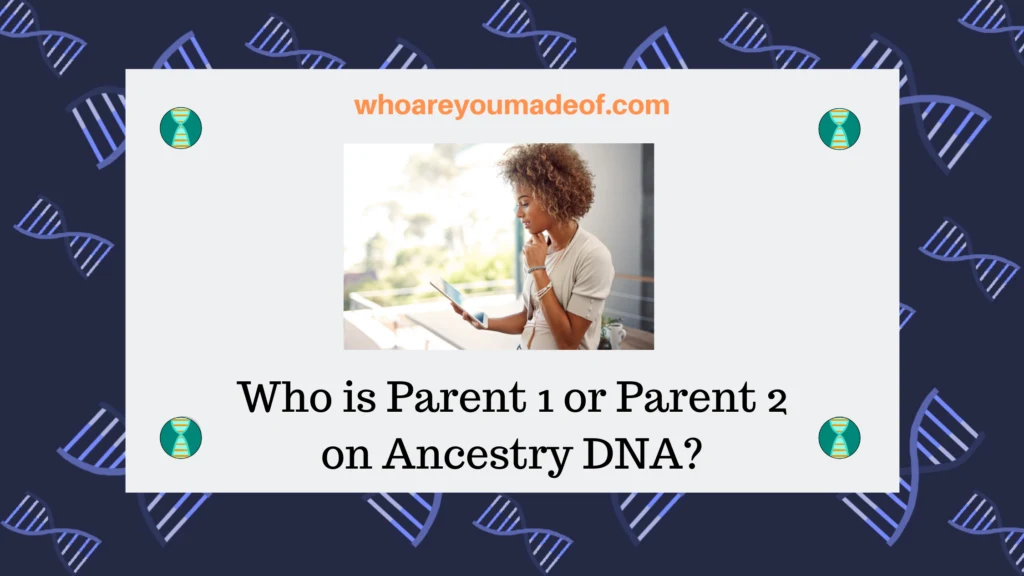
There are two main strategies for identifying Parent 1 and Parent 2 on Ancestry. The best method for you will depend on how much you know about your parents, your family tree, and whether any of your close relatives have also taken an Ancestry DNA test.
You will need to have an Ancestry subscription to use this feature. It's worth getting a subscription for the first few months after you get your results in order to get the most from your DNA match list.
Identifying Parent 1 and Parent 2 using DNA matches
The easiest way to figure out who Parent 1 and 2 are (i.e. your mother or father), is to examine your DNA match list. Your DNA match list automatically organized into two parental groups, but it is up to us to figure out which group belongs to each side of our family.
If you already know a lot about your family tree, or if many of your cousins on one or both side of your family have taken DNA tests with Ancestry, you will find this part to be very simple. You might even recognize some of the faces in the matches under one or both parental groups.
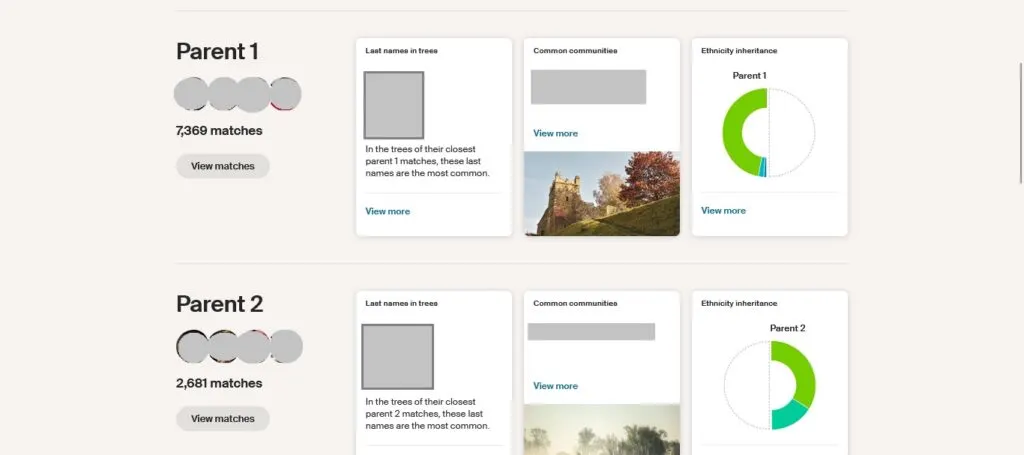
If you don't recognize the faces and common surnames included in either match group, click on the Parent 1 or Parent 2 match group to see if you recognize any of the DNA matches.
If you recognize some of the DNA matches on Parent 1 as being on your mother's side of the family, for example, this helps you understand that Parent 1 is maternal and Parent 2 is paternal. We only need to figure out the identity of one parent in order to know which side is which.
If you have no known, close relatives on either side of your family that you recognize from your list, and you know a little about your family tree, you could do a little research about your closest few DNA matches. By determining how a few DNA matches are related to you and which group (i.e. Parent 1 or Parent 2) they belong in, you will be able to know which is which.
Some people will will struggle to identify their relationship with their DNA matches, especially if they don't know very much about their ancestors. If you are unable to use DNA matches to figure out who is Parent 1 or Parent 2, then you might be able to use the ethnicity estimate, or the DNA Story, to do so.
Identify Parent 1 and Parent 2 using ethnicity estimate
Your ethnicity inheritance detailed comparison calculates which ethnicity regions were inherited from Parent 1 and Parent 2, and assigns a corresponding percentage that came from each parent. You can use what you know about your family tree to make a determination about which parent is your paternal and maternal side.
Below is an image from my Ancestry DNA results. Three of my mother's grandparents have only German, Polish, or Slovak ancestry, with the fourth grandparent having ancestors from Ireland, Scotland, and England.
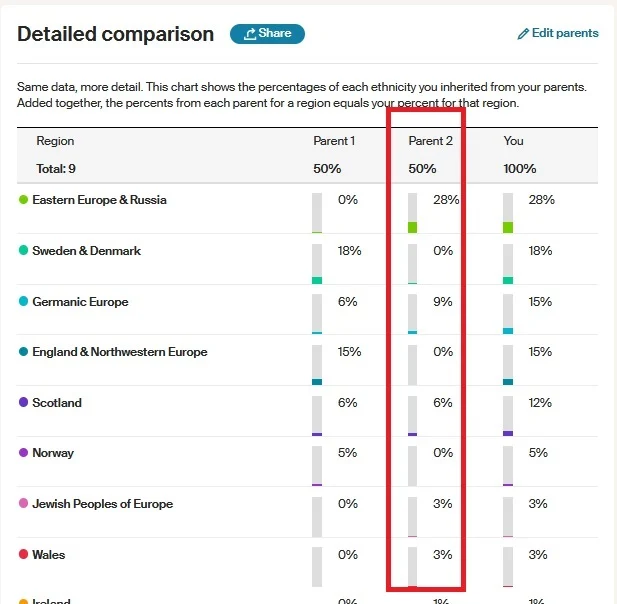
To me, it was clear that my mother's family tree and thus, likely contribution to my ethnicity estimate, was a good match for Parent 2. Once this feature was also rolled out for DNA matches, I was able to determine that my conclusion was the right one.
You can look at your ethnicity estimate comparison to see if you can spot a region or two that you feel is most likely to have been passed down from one parent and not the other. We can often expect to see small percentages matching neighboring regions near where our ancestors lived in our results, so this can help with clues, too.
What if both parents have the same ancestry or ethnicity?
It might be the case that both of your parents have a similar ancestry, and you don't know very much about your family tree on either side. This does present an additional challenge, but it is nothing that a bit more research can't help overcome.
For example, the DNA tester below has two parents who clearly had primarily Indigenous Americas - Mexico in their family tree, based on the DNA tester's 46% inherited from one parent and 47% from the other. You can see that they also inherited DNA from both parents in very small percentages (1%) matching several other regions.
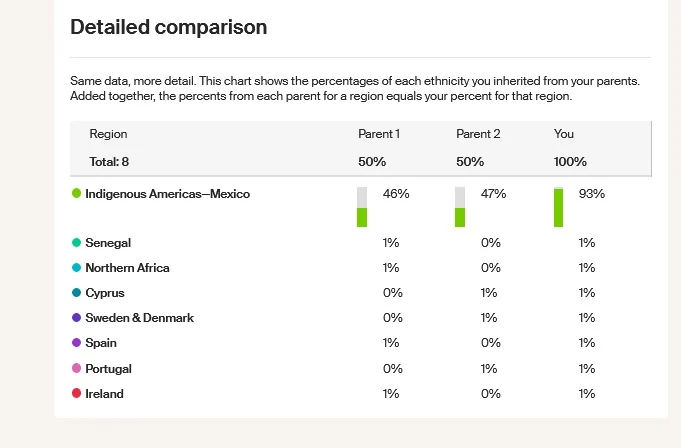
This person is only knows who their parents and grandparents are on both sides, and so is not able to determine whether one side of the family had a greater probability of also having distant Northern Africa, Cyrpus, Sweden & Denmark, Spain, Senegal, Portugal, or Ireland ethnicity. Since they only have 1% of their DNA matching all of these regions, it has proven difficult to trace.
Our DNA tester could follow one of two paths in order to figure out who Parent 1 or Parent 2 might be. The first would be to build their family tree further back, if possible, to see if they can learn enough about their ancestors on one side of the family in order to determine how they are related to some of their closer DNA matches.
What this Ancestry DNA customer has decided to do is ask his maternal half-brother to take a DNA test. Then, once his results come back and his DNA matches are re-assigned, he should be able to figure out which parent group (i.e. 1 or 2) his brother belongs to.
A more complicated method, only for the most determined of researchers, is to use a process called "triangulation" to determine how you are related to groups of DNA matches. This is a strategy used by many people to identify the immediate family of one's biological parents, and this method could also be used to identify which parent is maternal vs. paternal on the Ancestry DNA match list.
How to change the labels from Parent 1 and Parent 2
Did you know that you can change the labels from Parent 1 and Parent 2 to Paternal and Maternal, or vice versa? It's easy, and it will be less confusing when you view your DNA results.
Plus, if you change the labels, it won't matter if you forget which parent is Parent 1 and Parent 2; the labels will remind you. It's just more straightforward to assign a maternal and paternal label to your parent groups - especially when it comes to your DNA match list.
You can change the label on either your DNA Matches By Parent page or on the Ethnicity Inheritance breakdown by parent page. It will take just a few seconds to do, and you can always undo it if you make a mistake or want to change it later.
It doesn't make a difference which set of instructions you choose to follow below. If you change the labels on your DNA match list, the labels will automatically change on your Ethnicity Inheritance Breakdown, and vice versa.
Changing label for Parent 1 and Parent 2 on DNA match list
You can change the label for Parent 1 or Parent 2 directly on your DNA match list on the default DNA match By Parent page. This is the page that shows you how many DNA matches are assigned to each parent, as well as how many are unassigned.
On this screen, you will notice that there is a blue Edit parent link right next to the "View matches" button by both Parent 1 and Parent 2. Click on this blue link to assign a label to your parent.
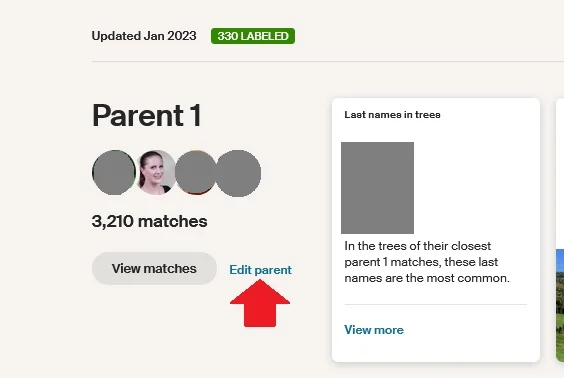
Once you click on the link, a window will appear (on the right side of the screen on a desktop or laptop) that will prompt you to assign this parent a maternal or paternal label. As you can see in the image below, it wants me to choose which side of the family my parent 1 DNA matches are on:
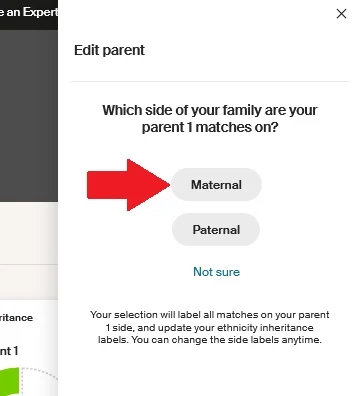
If I know that they are on my maternal side, I can choose the "maternal" label by clicking it. Once I do, my Parent 2 will automatically be assigned the "paternal" label.
Of course, if at a later point I want to change this assignment based on new information, I can repeat this process and choose a different label.
Changing label for Parent 1 and Parent 2 on Ethnicity Inheritance page
If you have not yet changed your parent labels, you can also do this on your Ethnicity Inheritance page, the same place where you can access the Chromosome Painter. You can only change the labels on this page for your own DNA test, not any of the kits that you manage.
To change the labels on this page, navigate to the Ethnicity Inheritance overview where you see the ethnicity breakdown by Parent 1 and Parent 2. Then, click the blue "Edit parents" link near the detailed comparison.
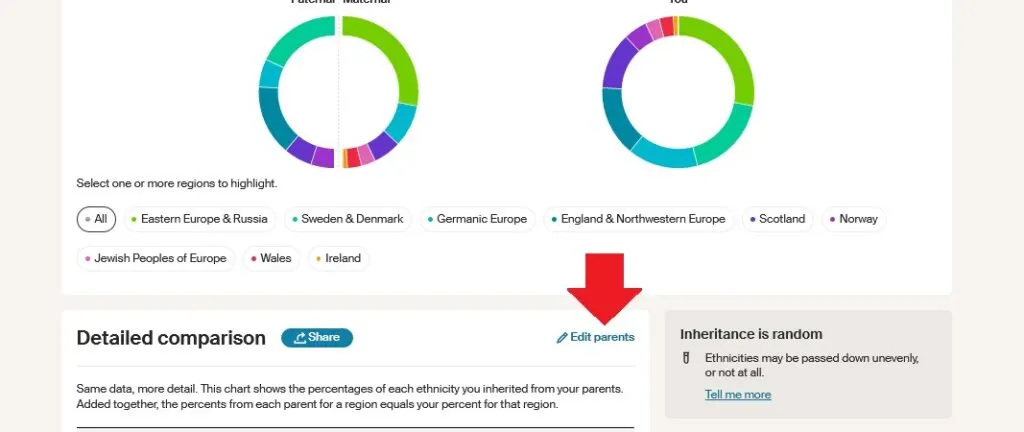
If you make a mistake, or if you later change your mind about which is paternal vs. maternal, you can always come back to this page and repeat the process to change labels. Any changes that you make to your parent labels on this page will also carry over to your DNA matches by parent, since both of these features are based on the Sideview technology.
Conclusion
I hope that this post has helped you understand everything that you need to know about how to figure out who Parent 1 and Parent 2 is on both your Ancestry DNA match list and ethnicity estimate. Once you've identified each parent, you will be able to learn even more from your DNA results.
If you have any questions about something that you read in this post, or if you would like to share something that you learned after you labeled each parent, I would love to hear from you in the discussion below.
Thanks for reading today.
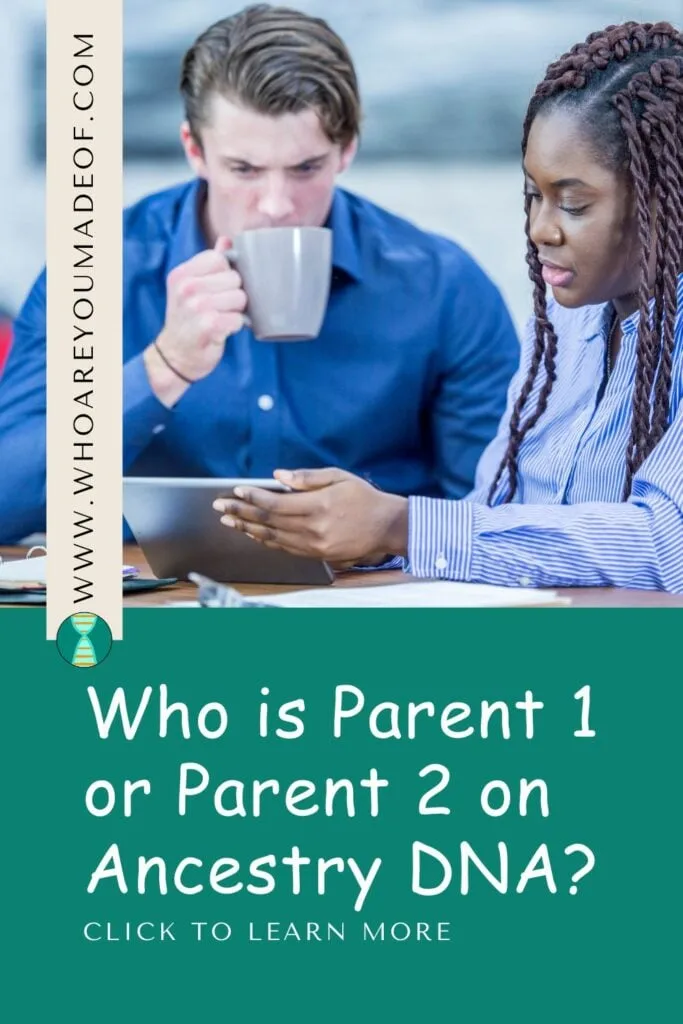


Liz Mayor
Tuesday 18th of February 2025
Why is it not possible to switch over one half of the pie chart to the other side. I was able to have my mother as Parent 1 on the left and my father as Parent 2 which suited me since, I believe that my mother should be Parent 1 as she gave birth to me. I did this a few years ago. I bought a subscription and DNA test for my partner who is not able to have the same set up as I have outline above. The technology does not let her swap it over. I have tried to explain this to Ancestry and, at first, they said it could be done but then it could not. With technology make great strides, I find this difficult to accept as it should be fairly simple or is there some sexism in the system - male, Parent 1 on the left and female, Parent 2 on the right. That would be very hard to accept such blatant sexism! Can you help?
Amanda
Friday 8th of March 2024
Hi. What if: ancestry keeps telling you that your half sister is a match on BOTH sides? Both mine and her fathers are dead, our mother is dead, so there's no chance of testing our parents.
Beatrice
Thursday 28th of September 2023
What happens when you have been adopted so you have no informations about neither one other than just one name and you won’t be able to understand who is parent 1 or 2 based neither the dba match or ethnicity?
Candace
Thursday 18th of May 2023
Thank you for this breakdown.